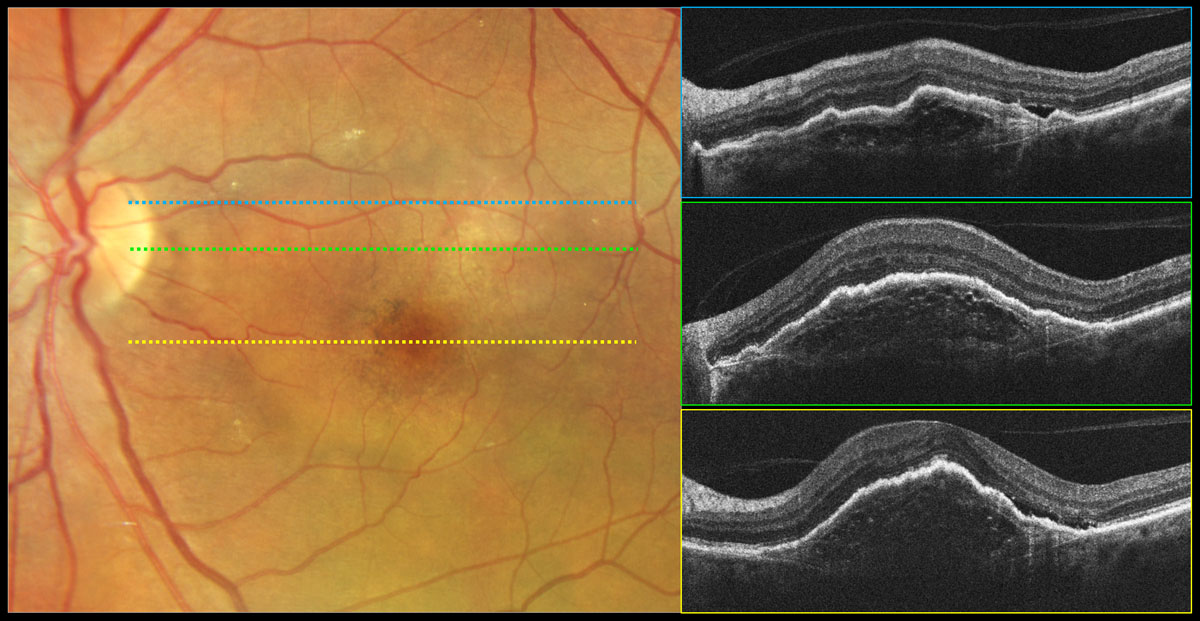 |
Dopamine precursor levodopa may provide protective effects against neovascular AMD conversion and diagnosis. Photo: Carolyn Majcher, OD. Click image to enlarge. |
While dry age-related macular degeneration (AMD) is generally less visually disabling to patients, especially in its earliest stages, the spectre of conversion to wet AMD looms large in the minds of patients. Neovascularization may not be totally unavoidable, but new research shows that exposure to the dopamine precursor levodopa (L-dopa), commonly used to treat Parkinson’s disease, may offer a protective effect in patients who need that medication. Perhaps in time the potent L-dopa, which carries significant side effect profile, will be studied as a potential therapy in AMD.
Two retrospective analyses and a case-control study considered the implications of levodopa exposure in: (1) wet AMD patients followed for two years, (2) dry AMD patients followed for one to five years and (3) newly diagnosed neovascular AMD cases that were matched with controls without neovascular AMD.
Eyes were divided into two groups: those exposed to levodopa before or on AMD diagnosis date and eyes t not exposed to the drug.
In the first study, the number of intravitreal injections used over a course of two years was one less on average for neovascular AMD eyes exposed to levodopa (11 rather than 12). When looking at studies two and three, L-dopa exposure in dry AMD eyes was associated with a 21% reduced risk of conversion at year two, 35% at years three and four and 28% at year five. Cumulative levodopa dose between 100mg to 300mg per day or greater than 300mg per day over two years was associated with decreased risk of neovascular AMD development by 14% and 23%, respectively.
Based on these findings, the researchers believe “these data from two non-overlapping independent databases support our hypothesis that L-dopa may be protective against conversion to neovascular AMD.”
Furthering this conclusion is the finding that eyes exposed to levodopa were in patients older than the control subjects, suggesting AMD might develop slower or later from a protective levodopa effect. In this study, non-neovascular control eyes were 76 years old on average, while levodopa-treated neovascular AMD eyes were 79 years old. Adding to this association’s credibility: older age was found to increase risk of neovascular AMD conversion by 4% to 5%.
Sex was another factor found to influence conversion risk, with male sex reducing risk to neovascular AMD conversion by 11% to 16%. Conversely, female sex was associated with 10% increased odds of developing wet AMD.
The researchers noted that levodopa can cross the blood-retinal and blood-RPE barriers and that 100mg to 300mg of the dopamine precursor would be “biologically justifiable” due to very high flow within the choroid.
However, they do caution that “there is a possibility of unexpected side effects in people without Parkinson’s disease, and we should refrain from easy use of L-dopa. Thus, a randomized, controlled clinical trial to test the ability of low-dose L-dopa at 100mg to 300mg per day to reduce the risk of conversion to neovascular AMD in high-risk eyes should be considered.”
Hyman MJ, Skondra D, Aggarwal N, et al. Levadopa is associated with reduced development of neovascular age-related macular degeneration. Ophthalmol Retina. May 3, 2023. [Epub ahead of print]. |

